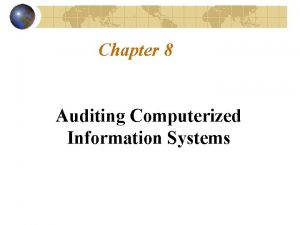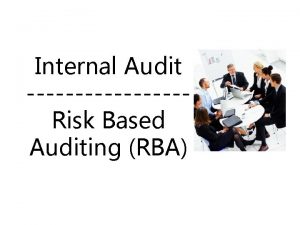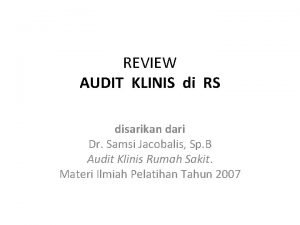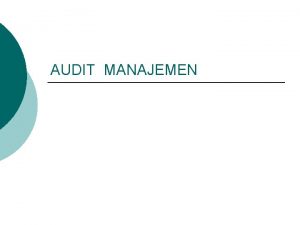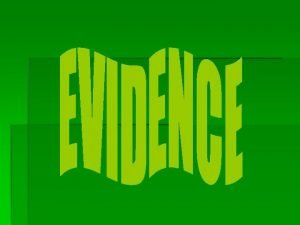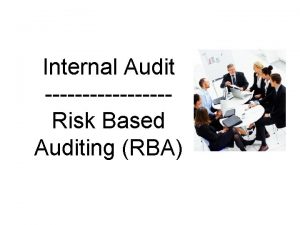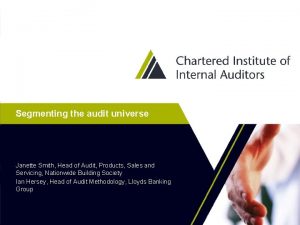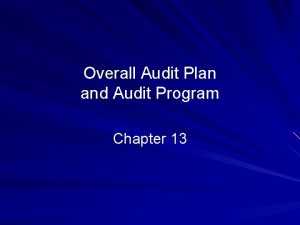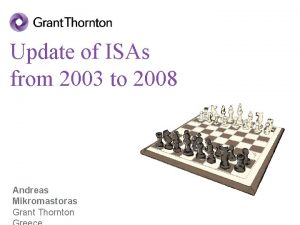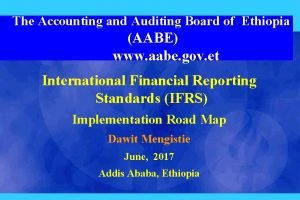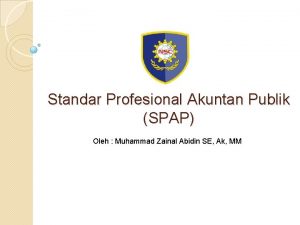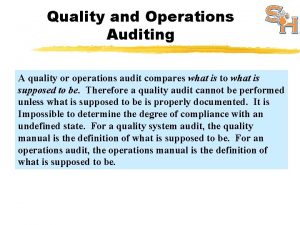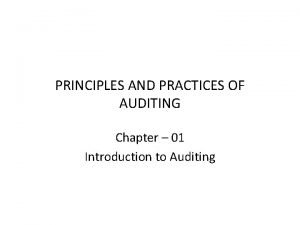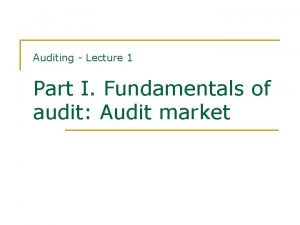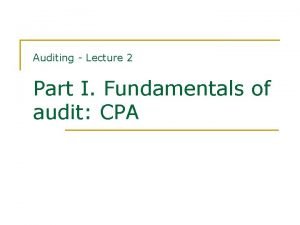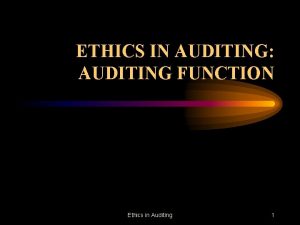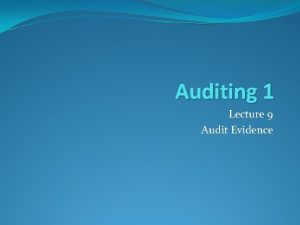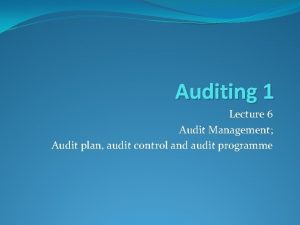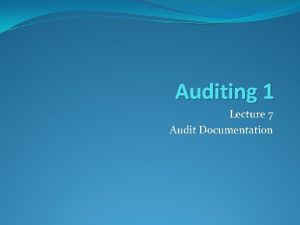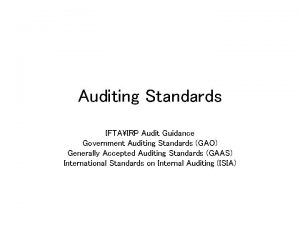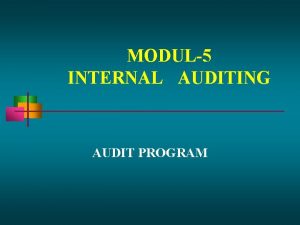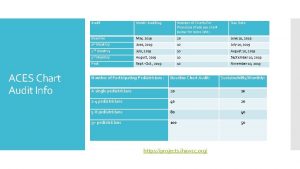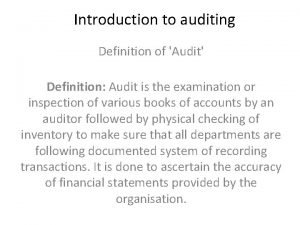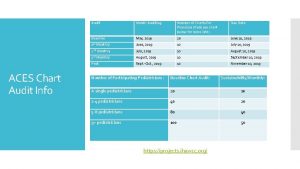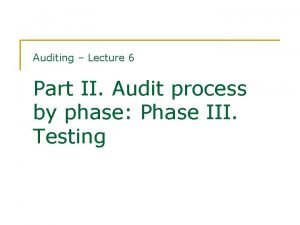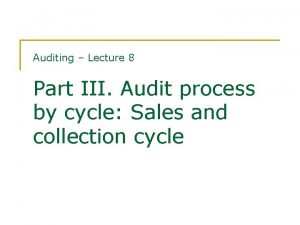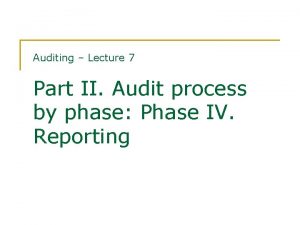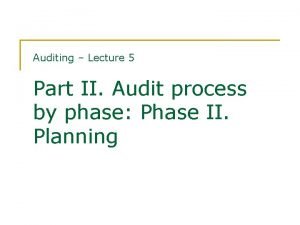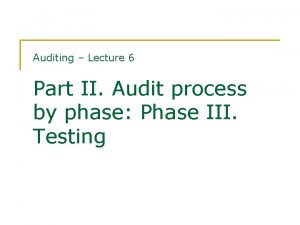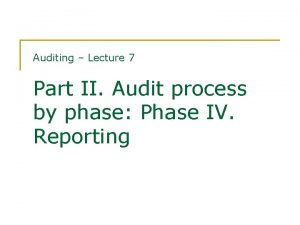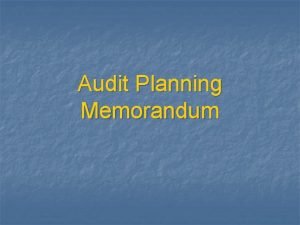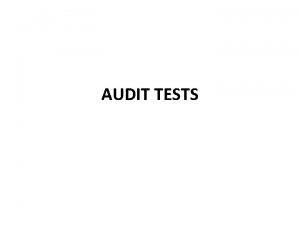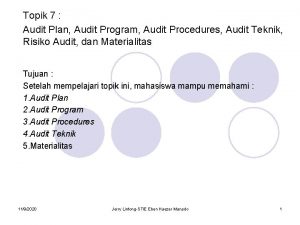Auditing Lecture 3 Part I Fundamentals of audit

























- Slides: 25

Auditing - Lecture 3 Part I. Fundamentals of audit: Ethics

Content n n Professional ethics Code of ethics Legal liability and defense (to be cont. ) Recommended reading Oct 5, 2015 2

Ethics –need for ethics n n n Ethics represent a set of moral principles, rules of conduct, or values. Ethics apply when an individual has to make a decision from various alternatives regarding moral principles. All individuals and societies possess a sense of ethics in that they have some sort of agreement as to what right and wrong are. Ethical behavior is necessary for a society to function in an orderly manner. It can be argued that ethics is the glue that holds a society together. The need for ethics in society is sufficiently important that many commonly held ethical values are incorporated into laws. However, many of the ethical values cannot be incorporated into laws because they cannot be defined well enough to be enforced. Most people define unethical behavior as conduct that differs from what they believe is appropriate given the circumstances. It is important to understand what causes people to act in a manner that we decide is unethical. There are two primary reasons why people act unethically: Oct 5, 2015 3

Ethics – need for ethics q q q Oct 5, 2015 “Everybody does it” - the argument that it is acceptable behavior to falsify tax returns, cheat on exams, or sell defective products is commonly based on the rationalization that everyone else is doing it and therefore it is acceptable. “If it’s legal, it’s ethical” - using the argument that all legal behavior is ethical relies heavily on the perfection of laws. Under this philosophy, one would have no obligation to return a lost object unless the other person could prove that it was his or hers. “Likelihood of discovery and consequences” - this philosophy relies on evaluating the likelihood that someone else will discover the behavior. Typically, the person also assesses the severity of the penalty (consequences) if there is a discovery. An example is deciding whether to correct an unintentional overbilling to a customer when the customer has already paid the full amount. If the seller believes that the customer will detect the error and respond by not buying in the future, the seller will inform the customer now; otherwise, the 4 seller will wait to see if the customer complains.

Ethics – ethical principles Ethical principles guiding the behavior and work of members of professional societies: q responsibilities - in carrying out their responsibilities as professionals, members should exercise sensitive professional and moral judgments in all their activities. q public interest – members should accept the obligation to act in a way that will serve the public interest, honor the public trust, and demonstrate commitment to professionalism. q integrity - to maintain and broaden public confidence, members should perform all professional responsibilities with the highest sense of integrity. q objectivity and independence - a member should maintain objectivity and be free of conflicts of interest in discharging professional responsibilities. q due care - a member should observe the profession’s technical and ethical standards, strive continually to improve competence Oct 5, 2015 and quality of services. 5 n

Ethics in accounting Our society has attached a special meaning to the term professional. Professionals are expected to conduct themselves at a higher level than most other members of society. A CPA, as a professional, recognizes a responsibility to the public, to the client, to fellow practitioners. n The reason for an expectation of a high level of professional conduct by any profession is the need for public confidence in the quality of service by the profession, regardless of the individual providing it. For the CPA, it is essential that the client and external financial statement users have confidence in the quality of audits and other services. n It is not practical for most customers to evaluate the quality of the performance of professional services because of their complexity. A financial statement user cannot be expected to evaluate audit performance. Most users have neither the competence nor the time for such an evaluation. Public confidence in the quality of professional services is enhanced when the profession encourages high standards of performance and conduct on the 6 Oct 5, 2015 part of all practitioners. n

AICPA code of conduct (USA) n The AICPA Code of Professional Conduct provides both general standards of ideal conduct and specific enforceable rules of conduct. There are four parts to the code: q principles - ideal standards of ethical conduct stated in philosophical terms. They are not enforceable. q rules of conduct - minimum standards of ethical conduct stated as specific rules. They are enforceable. q interpretations of the rules of conduct – prepared by the AICPA Division of Professional Ethics. They are not enforceable, but a practitioner must justify departure. q ethical rulings - published explanations and answers to questions about the rules of conduct submitted to the AICPA by practitioners and others interested in ethical requirements. They are not enforceable, but a practitioner must justify departure. Oct 5, 2015 7

AICPA code of conduct (USA) Oct 5, 2015 8

AICPA code of conduct (USA) Basic rules of conduct defined by AICPA Code of Professional Conduct: q Independence - because of its importance, is the first rule of conduct. The value of auditing depends heavily on the public’s perception of the independence of auditors. The reason that many diverse users are willing to rely on CPA’s reports is their expectation of an unbiased viewpoint. The AICPA Code of Professional Conduct defines independence as consisting of two components: independence of mind and independence in appearance. Ø Independence of mind - reflects the auditor’s state of mind that permits the audit to be performed with an unbiased attitude. It reflects a long-standing requirement that members be independent in fact. Ø Independence in appearance - the result of others’ interpretations of this independence. If auditors are independent in fact but users believe them to be advocates for the client, most of the value of the audit function is lost. 9 Oct 5, 2015 n

AICPA code of conduct (USA) SEC adopted rules strengthening auditor independence e. g. Sarbanes-Oxley Act (SOX). The SEC rules further restrict the provision of nonaudit services to audit clients, and they also include restrictions on employment of former audit firm employees by the client and provide for audit partner rotation to enhance independence. SEC prohibits CPA firms to perform the following services for public companies, who are their audit clients: bookkeeping and other accounting services; financial information systems design and implementation; appraisal or valuation services; actuarial services; internal audit outsourcing; management or human resource functions; broker or dealer or investment adviser or investment banker services; legal and expert services unrelated to the audit; any other service that the PCAOB determines by regulation is impermissible. CPA firms are not prohibited from performing these services for private companies and for public companies that are not audit clients. Oct 5, 2015 10

AICPA code of conduct (USA) q Oct 5, 2015 Independence of conduct: financial Interests – interpretations of rule on independence prohibit CPA members from owning any stock or other direct investment in audit clients because it is potentially damaging to actual audit independence (independence of mind), and it certainly is likely to affect users’ perceptions of the auditors’ independence (independence in appearance). Indirect investments, such as ownership of stock in a client’s company by an auditor’s grandparent, are also prohibited, but only if the amount is material to the auditor. The ownership of stock rule is more complex than it appears at first glance. Ø Covered members include the following: individuals on the attest engagement team; an individual in a position to influence the attest engagement, such as individuals who supervise or evaluate the engagement partner; a partner or manager who provides nonattest services to the client; a partner in the office of the partner responsible for the attest engagement; the firm and its employee benefit plans; an 11 entity that can be controlled by any of the covered

AICPA code of conduct (USA) q Oct 5, 2015 members listed above or by two or more of the covered individuals or entities operating together. Ø Direct vs. indirect financial interest - The ownership of stock or other equity shares and debt securities by members or their immediate family is called a direct financial interest. An indirect financial interest exists when there is a close, but not a direct, ownership relationship between the auditor and the client. An example of an indirect ownership interest is the covered member’s ownership of a mutual fund that has an investment in a client. Other rules of conduct – see general ethical principles (responsibilities, public interest, integrity, objectivity and independence, due care) 12

IFAC code of ethics (World) IFAC Code of Ethics contains three parts (A – Framework which applies to all professional accountants; B - Framework which applies to accountants in public practice; C - Framework which applies to employed accountants), declares basic principles governing conduct and work of auditors, and defines basic threats and safeguards for CPA professions and firms. n A – Framework which applies to all professional accountants defines the following principles: q Integrity and objectivity q Professional competence and due care q Confidentiality q Professional behavior q Tax practice q Cross-border activities q Publicity q Technical Standards Oct 5, 2015 13 n

IFAC code of ethics (World) B – Framework which applies to accountants in public practice defines a professional accountant in public practice as each partner or person occupying a position similar to that of a partner, and each employee in a practice providing professional services to a client irrespective of their functional classification (e. g. audit, tax or consulting), and professional accountants in a practice having managerial responsibility. Ethical guidance for accountants in public practice is offered in the areas of: independence; responsibilities to clients such as fees, commissions, and clients’ monies; and responsibilities to colleagues such as relations to other professionals, advertising and activities incompatible with practice. While referring to independence the Framework defines the following threats and safeguards to it: q Threats - self-interest threats, self-review threat, advocacy threat, familiarity threat, intimidation threat q Safeguards – safeguards created by the profession, legislation or regulation, safeguards within the assurance client, safeguards within the audit firm. Oct 5, 2015 14 n

IFAC code of ethics (World) n C - Framework which applies to employed accountants defines the following principles: q Conflict of loyalties q Support for professional colleagues q Professional competence q Presentation of information Oct 5, 2015 15

Business failure vs audit failure It is necessary to distinguish between business failure and audit failure: q A business failure occurs when a business is unable to repay its lenders or meet the expectations of its investors because of economic or business conditions, such as a recession, poor management decisions, or unexpected competition in the industry. q Audit failure occurs when the auditor issues an incorrect audit opinion because it failed to comply with the requirements of auditing standards. n Audit risk - represents the possibility that the auditor concludes after conducting an adequate audit that the financial statements were fairly stated when, in fact, they were materially misstated. Audit risk is unavoidable, because auditors gather evidence only on a test basis and because well-concealed frauds are extremely difficult to detect. An auditor may fully comply with auditing standards and still fail to uncover a material misstatement due to Oct 5, 2015 16 fraud. n

Prudent person concept There is agreement within the profession and the courts that the auditor is not a guarantor or insurer of financial statements. The auditor is expected only to conduct the audit with due care, and is not expected to be perfect. This standard of due care is often called the prudent person concept. It is expressed in Cooley on Torts* as follows: Every man who offers his service to another and is employed assumes the duty to exercise in the employment such skill as he possesses with reasonable care and diligence. In all these employments where peculiar skill is prerequisite, if one offers his service, he is understood as holding himself out to the public as possessing the degree of skill commonly possessed by others in the same employment, and, if his pretensions are unfounded, he commits a species of fraud upon every man who employs him in reliance on his public profession. But no man, whether skilled or unskilled, undertakes that the task he assumes shall be performed successfully, and without fault or error. He undertakes for good faith and integrity, but not for infallibility, and he is liable to his employer for negligence, bad faith, or dishonesty, but not for losses Oct 5, 2015 17 consequent upon pure errors of judgment. n

Legal liability to client n n The most common source of lawsuits against CPAs is from clients. The suits vary widely, including such claims as: q failure to complete a nonaudit engagement on the agreed-upon date q inappropriate withdrawal from an audit q failure to discover a theft of assets q breach of the confidentiality requirements of CPAs. Typically, the amount of these lawsuits is relatively small, and they do not receive the publicity often given to suits involving third parties. A typical lawsuit brought by a client involves a claim that the auditor did not discover an employee theft as a result of negligence in the conduct of the audit. The lawsuit can be for breach of contract, a tort action for negligence, or both. Tort actions are more common because the amounts recoverable under them are normally larger than under breach of contract. Tort actions can be based on ordinary negligence, gross negligence, or fraud. Oct 5, 2015 18

Legal liability to client n Defense from legal liability to client includes: q Lack of Duty – the CPA firm claims that there was no implied or expressed contract. The CPA’s use of an engagement letter provides a basis to demonstrate a lack of duty to perform. Many litigation experts believe that a well-written engagement letter significantly reduces the likelihood of adverse legal actions. q Nonnegligent Performance – the CPA firm claims that the audit was performed in accordance with auditing standards. Even if there were undiscovered misstatements, the auditor is not responsible if the audit was conducted properly. The prudent person concept establishes in law that the CPA firm is not expected to be infallible. Similarly, auditing standards make it clear that an audit is subject to limitations and cannot be relied on for complete assurance that all misstatements will be found. Oct 5, 2015 19

Legal liability to client Contributory Negligence - the auditor claims the client’s own actions either resulted in the loss that is the basis for damages or interfered with the conduct of the audit in such a way that prevented the auditor from discovering the cause of the loss. q Absence of Causal Connection - to succeed in an action against the auditor, the client must be able to show that there is a close causal connection between the auditor’s failure to follow auditing standards and the damages suffered by the client. n Third parties include actual and potential stockholders, vendors, bankers and other creditors, employees, and customers. A CPA firm may be liable to third parties if a loss was incurred by the claimant due to reliance on misleading financial statements. A typical suit occurs when a bank is unable to collect a major loan from an insolvent customer and the bank then claims that misleading audited financial statements were relied on in making the loan and that the CPA firm should be held responsible because it failed to perform Oct 5, 2015 20 the audit with due care. q

Legal liability to 3 d parties The leading auditing case in third-party liability was Ultramares Corporation v. Touche (1931), which established the Ultramares doctrine. In this case, the court held that although the accountants were negligent, they were not liable to the creditors because the creditors were not a primary beneficiary. In this context, a primary beneficiary is one about whom the auditor was informed before conducting the audit (a known third party). This case established a precedent that ordinary negligence is insufficient for liability to third parties because of the lack of privity of contract between the third party and the auditor, unless the third party is a primary beneficiary. n In recent years, courts have broadened the Ultramares doctrine to allow recovery by third parties in more circumstances by introducing the concept of foreseen users, who are members of a limited class of users that the auditor knows will rely on the financial statements. n Although the concept of foreseen users may appear straightforward, courts have generated several different interpretations. At present, the three leading approaches taken by the courts that have Oct 5, 2015 21 emerged are described as follows: n

Legal liability to 3 d parties q q q Oct 5, 2015 Privity - case of Credit Alliance vs. Arthur Andersen & Co. (1986) when the New York State Court of Appeals upheld the basic concept of privity established by Ultramares and stated that to be liable (1) an auditor must know and intend that the work product would be used by the third party for a specific purpose, and (2) the knowledge and intent must be evidenced by the auditor’s conduct. Restatement of Torts - foreseen users must be members of a reasonably limited and identifiable group of users that have relied on the CPA’s work, such as creditors, even though those persons were not specifically known to the CPA at the time the work was done. A leading case of this rule is Rusch Factors v. Levin. Foreseeable User - the broadest interpretation of the rights of third-party beneficiaries is to use the concept of foreseeable users. Under this concept, any users that the auditor should have reasonably been able to foresee as likely users of the client’s financial statements have the same rights as those 22 with privity of contract.

Legal liability to 3 d parties Defense from legal liability to 3 d parties includes: q Lack of Duty - contends lack of privity of contract. The extent to which privity of contract is an appropriate defense and the nature of the defense depends heavily on the approach to foreseen users in the country and the judicial jurisdiction of the case. q Nonnegligent Performance – it is often used when an auditor was unsuccessful in using the lack of duty defense to have a case dismissed. If the auditor conducted the audit in accordance with auditing standards, that eliminates the need for the other defenses. Unfortunately, nonnegligent performance can be difficult to demonstrate to a court. q Absence of Causal Connection – it often means nonreliance on the financial statements by the user. Absence of causal connection can be difficult to establish because users may claim reliance on the statements even when investment or loan decisions were made without considering the company’s financial condition. Oct 5, 2015 23 n

Civil liability under federal security law (USA) n n The Securities Act of 1933 deals only with the reporting requirements for companies issuing new securities, including the information in registration statements and prospectuses. The only parties who can recover from auditors under the 1933 act are the original purchasers of securities. The amount of the potential recovery equals the original purchase price less the value of the securities at the time of the suit. (If the securities have been sold, users can recover the amount of the loss incurred. ) The liability of auditors under the Securities Exchange Act of 1934 often centers on the audited financial statements issued to the public in annual reports submitted to the SEC as a part of annual Form 10 -K reports. Every company with securities traded on national and over-the-counter exchanges is required to submit audited statements annually. Obviously, a much larger number of statements fall under the 1934 act than under the 1933 act. Oct 5, 2015 24

Recommended reading n n n Arens et al. (2015) – chosen chapters will be uploaded to IS q Ch. 4 (whole), 5 (whole except 5. 1) Hayes et al. (2014) – chosen chapters will be uploaded to IS q Ch. 2 (2. 5), 3 (whole) AICPA Code of Conduct + IFAC Code of Ethics Oct 5, 2015 25
 Ifta audit manual
Ifta audit manual Parallel simulation audit
Parallel simulation audit 01:640:244 lecture notes - lecture 15: plat, idah, farad
01:640:244 lecture notes - lecture 15: plat, idah, farad Perbedaan audit konvensional dengan audit berbasis risiko
Perbedaan audit konvensional dengan audit berbasis risiko Perbedaan audit medis dan audit klinis
Perbedaan audit medis dan audit klinis Beda audit medis dan audit klinis
Beda audit medis dan audit klinis Penyelesaian audit dan tanggung jawab pasca audit
Penyelesaian audit dan tanggung jawab pasca audit Konsep dasar audit
Konsep dasar audit Perbedaan prosedur audit top-down dengan bottom-up
Perbedaan prosedur audit top-down dengan bottom-up Limitations of auditing
Limitations of auditing Perbedaan audit konvensional dengan audit berbasis risiko
Perbedaan audit konvensional dengan audit berbasis risiko Limitations of auditing
Limitations of auditing Internal audit universe
Internal audit universe Overall audit plan
Overall audit plan Part part whole addition
Part part whole addition Unit ratio definition
Unit ratio definition Part part whole
Part part whole Part by part technical description example
Part by part technical description example Front bar parts
Front bar parts The part of a shadow surrounding the darkest part
The part of a shadow surrounding the darkest part Two way anova minitab 17
Two way anova minitab 17 International standard on auditing 240
International standard on auditing 240 Aabe directives
Aabe directives Hirarki standar auditing
Hirarki standar auditing Operations auditing
Operations auditing Objective of auditing
Objective of auditing

